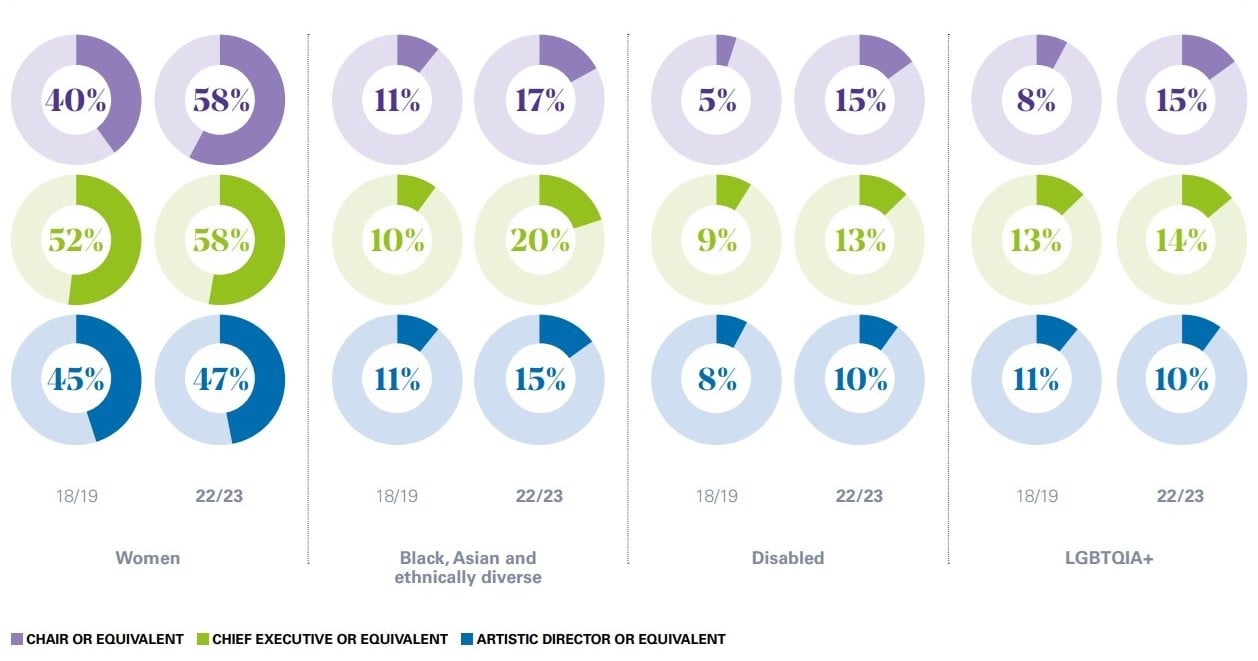
The proportion of ethnically diverse chief executives, artistic directors and chairs of National Portfolio Organisations have all risen
Photo: Pexels/cottonbro studio
Proportion of ethnically diverse chief executives at ACE-funded cultural organisations doubles
One in five National Portfolio Organisations had a Black, Asian or ethnically diverse chief executive or equivalent in 2022/23.
The proportion of ethnically diverse chief executives at Arts Council England (ACE) funded organisations doubled during the five years of the last National Portfolio, new figures show.
ACE’s Equality, Diversity and Inclusion 2018-23 report, published today (28 February) shows that 10% of National Portfolio Organisations had a Black, Asian or ethnically diverse chief executive or equivalent in 2018/19.
By 2022/23 this figure increased to one in five (20%). The proportion of ethnically diverse artistic directors also increased over the period, from 11% in 2018/19 to 15% in 2022/23. Meanwhile, the proportion of organisations with ethnically diverse chairs rose from 11% to 17%.
There were also increases in the proportions of NPOs with female or disabled chief executives, artistic directors and chairs.
The proportion of NPOs with chief executives or chairs who are LGBTQIA+ also increased, although the proportion of artistic directors fell slightly from 11% in 2018/19 to 10% in 2022/23.
Graphic: Diversity within leadership of National Portfolio Organisations

Meanwhile, across the entire NPO workforce the proportion of women rose from 46% in 2018/19 to 47% in 2022/23. The proportion of ethnically diverse workers rose from 12% to 15%, disabled workers rose from 5% to 9% and LGBTQIA+ workers rose from 7% to 12%.
Drop in audience diversity
However, there was a significant fall in the proportion of audience members who identified their ethnicity as mixed, Asian or Asian British, Black or Black British, or other in 2022/23.
According to the report, the proportion stood at 16% in 2018/19, but fell to 10% by 2022/23.
There was also a decrease in the proportion of audience members reporting a disability – from 12% in 2018/19 to 10% in 2022/23.
The report says that fewer audience members identified their ethnicity or whether they had a disability in 2022/23 than in 2018/19.
It adds that the data collected by organisations relies on the voluntary participation of audience members which “can lead to partial responses and under-representation in some areas of activity that might not paint a complete picture of engagement with arts and cultural events”.
‘Significant achievements’
Writing in the report, Nicholas Serota, chair of Arts Council England, said interpretation of audience data should take into account both the impact of the pandemic on behaviour and the limitations in obtaining an accurate picture of audiences.
“Over the last portfolio, audience data was largely captured through surveys and, among other shortcomings, these have a mixed takeup,” he said.
“It is in this context that the data suggests audiences were less diverse at the end of this period, than at the start. We introduced a new audience data platform, Illuminate, for our current National Portfolio which began in April 2023.
“Illuminate should allow us to understand where organisations might be experiencing barriers to data collection. It will also help us to work collaboratively to provide the right mechanisms, and options, around data capture for our very varied portfolio.
“Alongside this, the work we are doing with the other UK creative and cultural development agencies through our access scheme, All In should have a positive impact.
“The fact that there is further to go should not detract from the real and significant achievements that this review outlines.”
Join the Discussion
You must be logged in to post a comment.